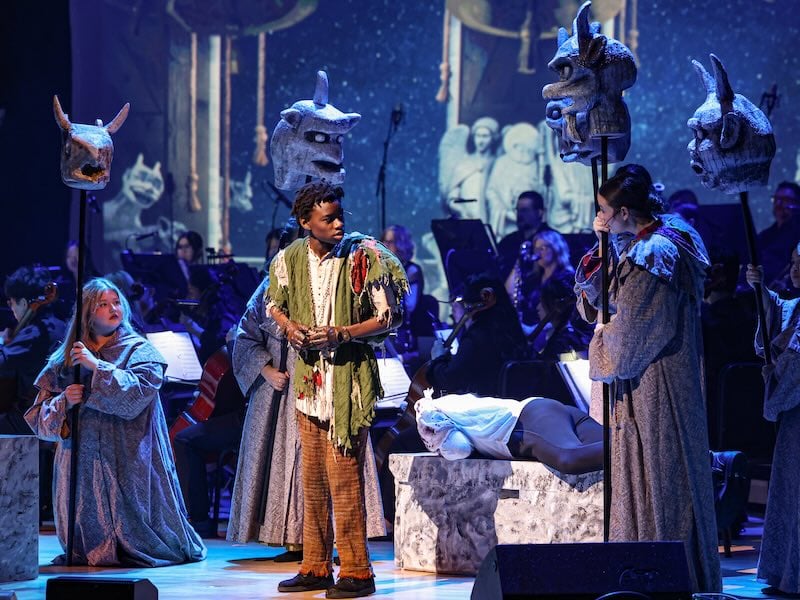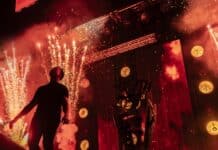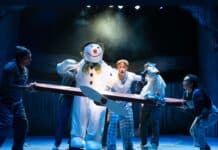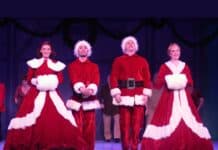If I were to describe Young Artists of America’s (YAA) gala production of The Hunchback of Notre Dame at Strathmore Music Center in five words, it would be: huge, crazy talented, comfortably mature. I never thought I would see a production of Disney’s Hunchback in the DC area; I couldn’t think of a DC theater with the space and resources to do it justice. But YAA’s presentation this past weekend may just be the shining example of how to do it, with semi-staged treatment yet full commitment in a concert production; impressive maturity and lively age-appropriate choices by its principals; and a special spirit with over 200 young people.
An adaptation of the classic Disney Renaissance movie with a beloved Alan Menken score, based on Victor Hugo’s book, it follows hunchback Quasimodo’s journey to find freedom while living as a ward to the misguided priest Frollo, who wants gypsies like Esmeralda and leader Clopin gone from Paris. The soldier Phoebus has returned from war and is changing his mind about following orders. There’s a love square of sorts; everyone’s in love with Esmeralda — Phoebus’ love returned, Quasimodo’s unrequited, and Frollo’s in the form of lust and “savior complex”— but Esmeralda really likes Phoebus. (Not the fault of this production, but in this adaptation, Esmeralda, Phoebus, and Frollo’s stories feel more expanded at the expense of Quasimodo’s arc, especially in the second act. There’s some room for development.)

This musical was produced at Paper Mill Playhouse in 2015, which I saw when I was in high school. In direction, I noticed an element of the original concept: Quasimodo stepping out from the ensemble to put on the hunchback costume and taking it off at the end of the show, symbolizing his physical disability. Most production design seemed to want to bring the movie to life onstage as much as possible to make up for not having large sets, including Esmeralda’s iconic dress, realistic gargoyle head props on long sticks, an extensive costume for a hysterical visual gag with the one-scene character of Saint Aphrodisius, stark robes for storytellers, colorful dresses for the gypsies, and projections on a screen upstage of the action with scenes of Notre Dame, Paris, and various locales. In this production, director Carole Graham Lehan and choreographer Alyxzandra Blanch worked with limited playing space in front of and behind the orchestra and still created interesting stage pictures.
The orchestra needed that space because it was a 50-piece orchestra. Theaters don’t do this show often because it requires a choir beyond the ensemble, and enough to lose from doing a show with less name recognition than other Disney options. For YAA, it took collaborations with multiple programs they run to make it happen: their musical theater company, orchestra, and three choirs in the choir lofts above the stage (which included their two choirs and an invited choir from Richard Montgomery High School). Vocal director Rolando Sanz and the choral preparation team of Paul Heinemann, Kathryn Bailey Erath, and Sidney Clarke-Lequerique accomplished a wondrous feat. The show seems fit for YAA due to its scale (all those families had to come!) and its leadership’s ability to inspire truthfulness to the story.
Luka van Herksen’s Quasimodo was soft yet strong: subtle in his acting choices in the “real world,” where the character struggles with speech, and more expressive in his own little world with the gargoyles. It made for a production where the big choices of Frollo and Esmeralda made it more of an ensemble story, not just Quasimodo’s story. The casting of a Black teen in this role is inspired, especially as he interacts with a fellow Black cast member at the end of the show when he removes the hunchback clothing and passes it on to him. I wonder why the direction had him physically hold his face at times, when the point is that the actor isn’t actually physically disfigured, and focus shouldn’t be on his face. But in his solo moments, he takes control. His voice had interesting pop/rock inflections, making classic Disney music his own.

As Frollo, Ryan Robbins had much maturity with his strong, deep bass voice, making him the one to watch right from the beginning of the show. He could be eerily calming and somehow logical, then at the next moment, terrifying. He commanded a fierce presence. Veronica Romero gave a Disney princess-like take on the role of Esmeralda, an empowered gypsy woman who wants to be treated right. It was perhaps less gritty, but still captivating, because she had such a bright presence and a gorgeous, soprano voice that shone in her take on “God Help the Outcasts.” I appreciate that the production didn’t gloss over the sexualization of her character in interactions between Frollo and Esmeralda, but stayed cognizant of the fact that she was played by a high schooler and didn’t force her to go through more than that.
Jesse Kliman’s Clopin and Seger Ott-Rudolph’s Phoebus were classic portrayals of the characters, making strong physical and vocal choices as actors and singers that characteristically defined the magical leader of the gypsies and the traditional tenor love interest. (Kliman also held down the bass part in ensemble moments; amid all the choirs and the ensemble, I could make out his amplified voice.)
Standouts from the ensemble were Anah Ambuchi, Sofia Bailey Guerra, Sophie Beck, Harper Herndon, Erin Leberknight, Nyah Magsino, Hamsini Tikkisetti, and Lexi Whelan as the gargoyles, with entertaining encouragement and attitude toward Quasimodo — and well-executed choreography with their gargoyle prop heads. And the storytellers narrating with solo lines throughout all had their own perspective as they shared Quasimodo’s story.

There was so much strength and confidence. There were the littlest of nit-picky line reading moments, but it’s not worth it to point them out because of the empowerment and joy that cancels them out. Any notes on “Be just a bit more truthful!” or “Let the moment linger a little longer and land more!” would be figured out with more than one performance in such a vast space.
To someone who’s been part of youth-driven theater environments in the DC area, and young pre-professional training programs of similar caliber to YAA growing up, this is a program with incredible resources. Being part of such programs makes a difference; the seniors who burst into tears when they received scholarships after the show exemplify this. Even professional performers rarely get to do musical theater with a full orchestra conducted by Kristofer Sanz, who had to cue five different groups at once at any given moment. This was a special mega-performance: not just your average Hunchback. It was inspiring to see it in a time when one could use a lot of hope.
Running Time: Two hours and 30 minutes, with a 15-minute intermission.
Disney’s The Hunchback of Notre Dame played one night only, April 26, 2025, presented by Young Artists of America performing at the Music Center at Strathmore, 5301 Tuckerman Lane, North Bethesda, MD.
The program for Disney’s The Hunchback of Notre Dame is online here.
Disney’s The Hunchback of Notre Dame
Music by Alan Menken
Lyrics by Stephen Schwartz
Book by Peter Parnell
Based on the Victor Hugo novel and songs from the Disney film
SEE ALSO:
Young Artists of America to present largest production of Disney’s ‘Hunchback’ ever staged (news story, March 27, 2025)



